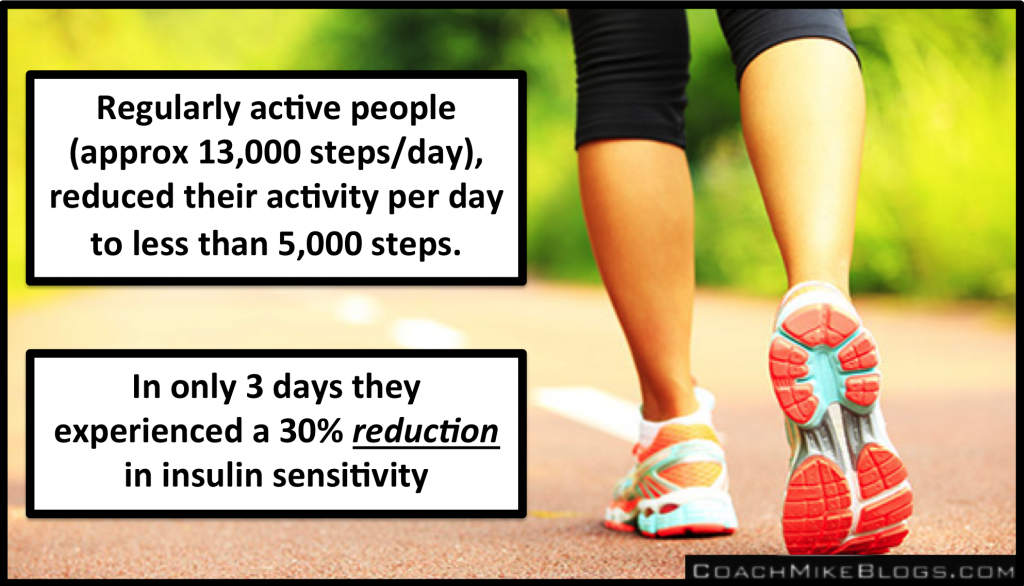The average North American may only perform 5,000 steps day, but we’re designed to be performing at least twice that. With the hunter gatherer humans that came before us executing an extremely large volume of daily physical activity, and this daily practice altering the expression of a significant number of genes related to heart health, immunity, glucose management, and a variety of other key factors.
In 2010, the ongoing Japanese Nakanojo Study determined that the optimal threshold for improved physical health is greater than 8,000 steps/day.

Hippocrates was spot-on when he said “Walking is a man’s best medicine” – as research has demonstrated it’s effectiveness in everything from reducing blood pressure and inflammation, to improving memory and cognitive function (1, 2), to increasing lifespan. However, we can also expect modest improvements in body composition because of increases in fat burning and resting metabolic rate, improvements in insulin sensitivity and reductions in cortisol.
Researchers in the journal Medicine and Science in Sports and Exercise, published a study in 2012 that had regularly active people (nearly 13,000 steps per day), reduce their activity per day to less than 5,000 steps. In only 3 days they experienced REDUCTIONS in insulin sensitivity by 30%!
Fat is not only the predominant fuel source during lower-intensity exercise, but research points to superior fat loss with higher exercise ‘frequency’ as opposed to ‘duration.’ Meaning, the more OFTEN you move, the better results; and with a low-impact, low-intensity, stress-reducing exercise like walking, performing this activity regularly is very feasible.

One of the driving forces in the health improvements from walking are because of it’s ability to reduce inflammation. Which, just like an anti-inflammatory eating strategy, is a significant contributor to the health of our brain and heart, and overall longevity.
Just 20 minutes of walking reduces hypertension by 29%, and improves brain function by 1800!
Arguably, the health improvements in the brain appear to be the biggest benefit from walking. Since, along with reducing inflammation, walking supports the function of brain neurons, which leads to improved memory, mood, and cognitive function – and a lower risk of dementia and depression.
Meaning, walking should be an integral component to extending your healthspan. Especially in the elderly, where cognitive function is known to be an independent predictor of morbidity and mortality.

Regular activity also has a positive impact on AGEs (Advanced Glycation End Products), which are a key risk factor for heart disease, dementia, and diabetes. Specifically, it’s been shown to lower Hemoglobin A1C more than many diabetes medications:
A 2010 study on 70 participants with Type 2 Diabetes, determined that the group exercising 3 times a week dropped their A1C score by 0.73, whereas a sedentary group increased their A1C score by 0.28.
As discussed in Eat Meat And Stop Jogging, chronically elevated blood sugar (hyperglycemia) is a common theme in degenerative diseases of the brain and heart, and it’s largely driven by a reduction in glucose tolerance (insulin resistance). So one of the reasons we see such drastic improvements in disease prevention with walking, is because it improves our sensitivity to insulin and helps normalize blood glucose.
In the Diabetes Prevention Program, researchers determined that 150 minutes of walking per week reduces type 2 diabetes risk by 58%!
And since, impaired glucose tolerance is also associated with cancer, this is likely why we also see walking correlated with cancer reduction.
The American Cancer Society Prevention Study II Nutrition Cohort collected data from 73,615 postmenopausal women and found that those walking more than 7hrs per week had a 14% lower risk of breast cancer than those walking less than 3hrs.

The best part about all these improvements in health is that they don’t require much effort. You can significantly reduce your risk without even breaking a sweat.
Take the stairs, walk to the grocery store, walk around the mall, do a few laps of the office, putter around while you’re on the phone, go for a walk instead of watching t.v., walk over to speak to a coworker instead of emailing them, or park your car a little further than you normally do.
Stay Lean!
Coach Mike
RELATED ARTICLES:
5 Exercises You Should Be Doing Daily
Intensity = Lift More Weight NOT Lift Weight More
The Elderly Should Train For Strength & Muscle NOT Endurance
